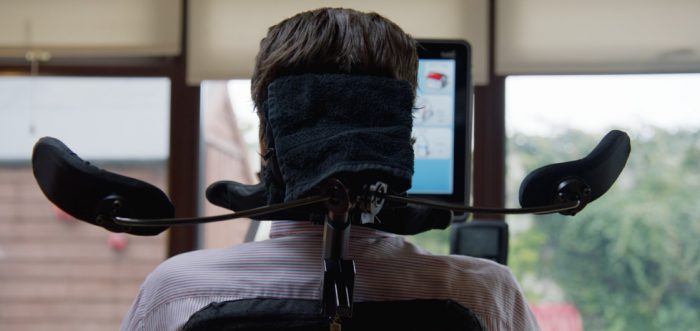
Frankie Fenton’s It’s Not Yet Dark, a documentary on the life of director Simon Fitzmaurice, who was left paralysed and mute after developing Motor Neuron Disease, opens with footage of the director being wheeled behind a screen playing the credits to a film. The credits finish and the screen rises to reveal a crowd standing up and cheering, as Fitzmaurice sits completely immobile in his wheelchair. Towards the end of the film we learn that this footage is from the premiere of Fitzmaurice’s debut feature My Name is Emily at the 2015 Galway Film Fleadh, but here, without the context of the film that has just screened to the audience, or really any clear indication so far that Fitzmaurice is the director of said film, it’s a very odd moment. The scene plays like what some disability activists have dubbed “inspiration porn” – media that calls people with disabilities inspirational solely because they have a disability. Unfortunately, it becomes very clear very quickly that the strangely condescending nature of Fenton’s opening image isn’t an ironic set-up for later deconstruction. Rather, it’s emblematic of the rest of the It’s Not Yet Dark, a well-meaning if misguided film that makes no real attempt to align us with its subject’s situation, thus doing a great disservice to both him and other suffering from MND. Fenton doesn’t want us behind stage with Fitzmaurice at all. He wants us in that audience clapping.
From that opening, the film progresses in a fairly straightforward manner, telling Fitzmaurice’s life story through talking head interviews with friends and family, archival photos and videos, and excerpts from Fitzmaurice’s book read in voice-over by actor Colin Farrell. The story covers Fitzmaurice’s early childhood, to his time at school, to burgeoning interest in literature and cinema, to the meeting of his wife, to his film career, to his developing of MND, to his experience learning to live and work with it (through the help of an eye-tracking computer), and eventually to the directing of My Name is Emily (also screening at this year’s Sydney Film Festival). Conventional as it is, it’s mostly competent filmmaking, with Fitzmaurice’s story well communicated and engaging. There are some truly affecting moments, particularly as Fitzmaurice shares his feelings towards how his MND will affect his wife and children, and a good case is made for him as a promising artist, with two acclaimed shorts and a successful career in commercials behind him as he embarks on his debut feature.
It’s only more of a shame, then, that we’re never asked to seriously consider what it might be like to live and work with MND. This isn’t helped by a few truly laughable moments, like the intercutting of “poetic” but totally unrelated landscape drone shots, or an unfortunate pairing of sound and image: voice-over recounts the moment Fitzmaurice was told his MND may be fatal and that he should prepare for “the journey… of death” just as we’re shown a POV shot of a train entering a dark tunnel and emerging to a bright light on the other side. It’s frustrating how often the film avoids doing anything particularly ambitious, something especially in the wake of last year’s Notes on Blindness, a film which develops its own unique form around the notion of what it was like for its subject, John Hull, to go blind.
In It’s Not Yet Dark, the making of My Name is Emily is virtually brushed over in the last 15 minutes of the film. If this is really the most interesting part of Fitzmaurice’s story – his directing of a feature film while completely mute and paralysed – then why not show us that process, touching on life events and backstory as they become relevant? Why not interrogate what it’s like to write or make storyboards via eye-tracking, or what it’s like to only be able to communicate with crew and cast through a computerised voice that takes time to type up? Ruth Fitzmaurice, Simon’s wife, tells us that her family rejected an automated version of Simon’s pre-MND voice to be used with his computer because the computerised voice had become Simons’ regular voice to her and their children. So why not have Simon narrate the film himself, rather than having narration by Colin Farrell?
If anything, the conventional “life story” approach asks that he be seen only in the context of his disability, rather than the person he is and how he’s living and working right now. Fitzmaurice has such little hand in actively telling his own story that you’d think it was made after his death. For a film that proclaims that “the best thing about living with MND, is the living part”, that’s a bit of a problem.
At the end of the film, the shot of the screen rising at Galway re-appears. Now we have the context, but ironically the unintended sting even is harder. Fitzmaurice tells the audience at the screening that “I wrote the script to direct it. MND had nothing to do with it. I was not trying to prove anything.” It’s a shame the filmmakers of It’s Not Yet Dark don’t share his attitude.
